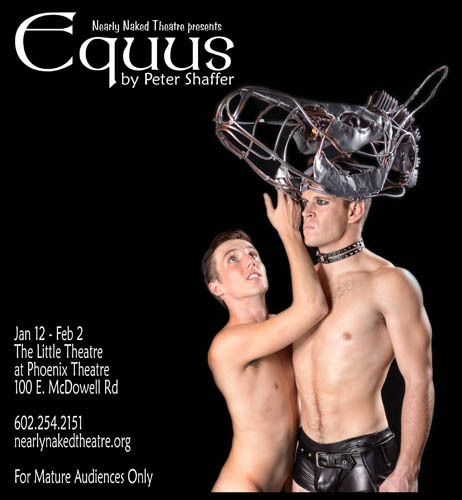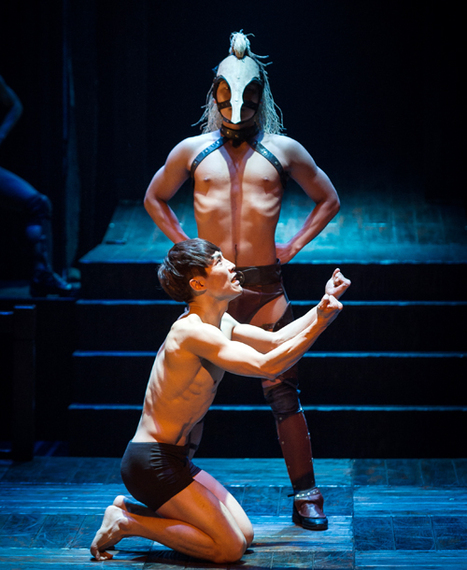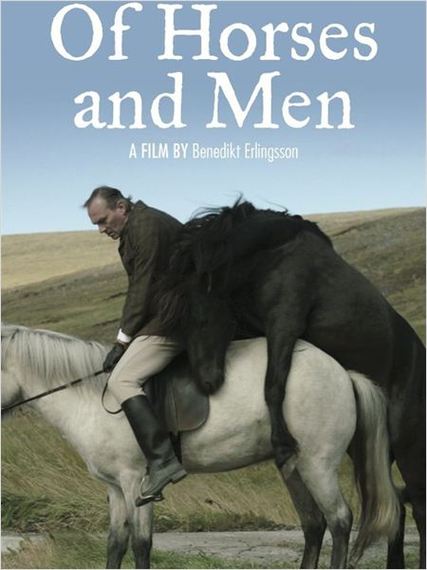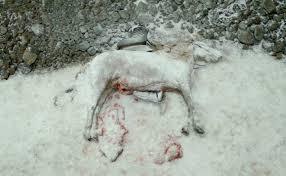Some animals seem more expressive than others. Some have physiques that inspire artists more than others. To me, one of the most impressive mammals can not only be seen throughout the animal kingdom, but throughout popular culture as well.
From a talking horse (Mr. Ed) to The Horse Whisperer, from heavily anthropomorphized cameos in full-length Disney animated features to the leading role in 2002's Spirit: Stallion of the Cimarron, horses are often seen as sensitive, muscular, and loyal creatures.
Bringing a live horse onstage, however, poses technical problems. Many an operatic performance has been sabotaged when a nervous steed decided to relieve himself onstage. Many years ago, during a dress rehearsal of the Kermesse scene in Faust, a horse let loose as he approached center stage. When asked for his reaction, the conductor snorted "God, what a critic!"
While many make jokes about the phrase "hung like a horse," during my 1987 trip to Scandinavia, I was surprised to see how much porn was dedicated to young blonde women and their horses. The sexual appeal of a horse, however, is hardly limited to women.
Poster art for a production of Peter Shaffer's Equus
at Nearly Naked Theatre in Phoenix, Arizona
In 1973, Peter Shaffer's award-winning psychodrama, Equus, took audiences on a wild ride as a child psychiatrist attempted to work with a 17-year-old boy who had blinded six horses in a stable. As the play progressed, the psychiatrist realized how sterile, repressed and false his life had become while his anguished patient was taking a favorite horse out on midnight rides through the countryside that often brought the young man to orgasm.
Alan prepares to take Nugget out for a midnight ride in Equus
(Photo courtesy of South Korea's Shilhum Theater Group)
Needless to say, some basic skills with Photoshop can go a long, long way:
Using life-sized puppets created by Cape Town, South Africa's famed Handspring Puppet Company, the Royal National Theatre's 2007 world premiere production of War Horse thrilled audiences. The intense flexibility and appeal of the production's puppets created a magical experience which subsequently toured the world. In the following clip, a member of the Handspring Puppet Company explains how the puppet for Joey the Horse functions.
The 2014 San Francisco International Film Festival featured two entries (one a 15-minute short, the other 90 minutes in length) in which horses -- in their natural state -- were the focus of each film. One was a black-and-white piece of narrative fiction; the other a full-color, full-length feature. Each, however, had a fascination all its own.
* * * * * * * * * *
Take two trained animals -- a mare and a German Shepherd -- and put them on camera in the snowy terrain near Riobamba (the provincial capital of Chimborazo in northern Ecuador). If the only sounds of communication are the dog's excited barking and a few snorts and grunts from the mare, is there any kind of connection between the two animals? Can the footage they generate deliver a movie?
Written, produced, and directed by Jorge López Navarrete, Little Block of Cement With Disheveled Hair Containing The Sea offers a resounding yes to those questions. An essentially plotless film, Navarrete's short is all about coexisting in nature. His work should not be seen as a stereotypical film about animals bearing heavy anthropomorphic messages, but rather as a wilderness tone poem of exquisite simplicity. As the filmmaker explains:
"A dog and a mare embark upon a voyage together. With every step they take, the differences between them become inevitably clearer, and yet the profound mutual knowledge they develop over time shows the potential to suddenly produce a luminous moment between the two. This is a story of needing, of searching, and, above all, of coexisting. The idea of romantic love, in whose name we decide to share our life with someone, often masks other types of needs that have no relation with a firm belief in mutual and unconditional surrender as the ideal manner of living. Nevertheless, the decision to come together and share our life with another person, despite innumerable disagreements, eventually provides a valuable experience for both parties.
The approach was to concentrate all the action on the dog and the mare, their being the only elements shot with close-ups, and to keep artifice to a minimum. Nature is an additional, third main character of the story. This is the reason why, from the very beginning, I had the conviction to locate the story in an exuberant and diverse Latin American country. I eventually decided on Ecuador because of the geographic proximity of the contrasting landscapes (which was extremely convenient for a low-budget production requiring short trips)."
Navarrete's short has its ups and downs, but what is never in question is the quality of Carlos Mora's cinematography and Carlo Marchionni's musical score. Here's a teaser:
* * * * * * * * * *
Written and directed by Benedikt Erlingsson, Of Horses and Men contains what may seem like the most uncomfortable threesome in cinema history. A snapshot of the moment (in which an old gray mare proves that she ain't what she used to be) was chosen as the best candidate for marketing this Icelandic film.
Poster art for Of Horses and Men
An Icelandic actor and stage director turned film director, Erlingsson's directorial debut shows evidence of an extremely dark sense of humor combined with a lifelong love of horses (he got his first horse when he was 16 years old as part of his salary for working as a "harvest boy" on a horse farm in the highlands of northern Iceland). "To work with horses was amazingly easy," he confesses. "And, of course, they are not in any union, which made the producer very happy."
In this charming interview, taped during the 2013 Toronto International Film Festival, Erlingsson discusses his theatrical background, his family's history as storytellers, the challenges of working with horses, and the difficulty of raising money for a film when your island nation has essentially gone bankrupt.
Many moments in Of Horses and Men defy description. Frequent shots of humans reflected in a horse's eye keep the audience aware that this story is not always being told from a human perspective. As the plot synopsis on IMDB so deliciously explains:
- "Kolbeinn loves Solveig and Solveig loves Kolbeinn. But Kolbeinn is in love with his prized possession and darling, the mare Grána and Grána is obsessed with the stallion Brúnn. Spring is coming and the whole community is following the story. This cannot end well.
- Vernhardur is in love with vodka and the horse Jarpur loves Vernhardur, his master. Aboard a Russian trawler is a mate by the name of Gengis (who doesn't have vodka but loves horses like Jarpur). This is not going to end well.
- Grimur has a passion for ancient horse roads but Egill admires barbed wire fences. Grimur owns a horse and a pair of pincers. Egill owns a tractor. This cannot end well.
- Johanna loves Raudka, her mare, but Raudka is in love with freedom. On the heath by an old summer cottage lies an injured old man. This could have a happy ending.
- Juan Camillo loves life and nature and is seeking God in the Icelandic highlands. But the horse, Old Piebald, is tired and longs for rest. How will this end?"
Blessed with Bergsteinn Björgúlfsson's magnificent cinematography and David Thor Jonsson's lively musical score, Of Horses and Men is a compellingly peculiar movie which highlights the animal within all of us (and occasionally depicts men who, in their desperation to survive, must depend on their horses). The film was made with a large cast of horse lovers and horse owners who are completely unknown to movie buffs.
I found Of Horses and Men to be utterly captivating; the kind of movie one should experience rather than read about. Despite what one may assume from some clever editing, no horses were harmed in the making of the film. Here's the trailer:
To read more of George Heymont go to My Cultural Landscape





